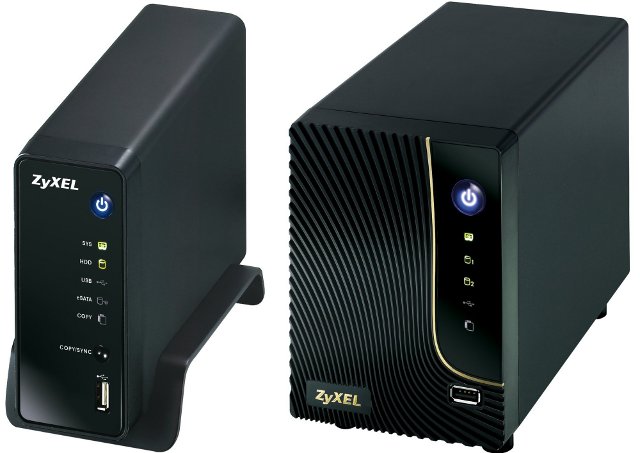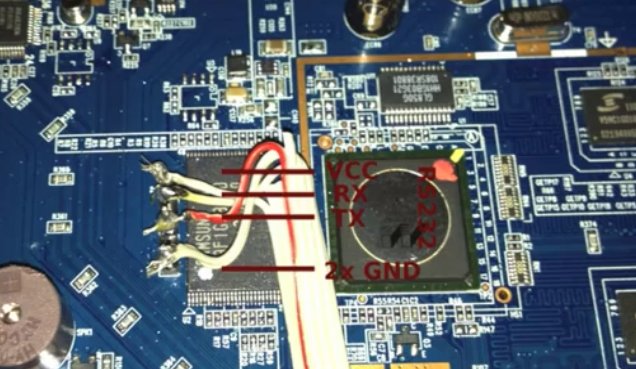Yesterday, we saw how to make a NAS enclosure for the Cubieboard, but DesertF0x commented “Better take a NSA-310 or NSA-320. It is easy to install Debian and it has Gigabit!”, and I decided to have a look. The 2 devices appear to have been released at the end of 2011, and are powered by a Marvell ARMv5 compatible processor. Many NAS are expensive kits, but NSA310 (1 bay) is currently available for $88.50 and NSA320
(2 bays) for $95.34 on Amazon, which is just a little cheaper than the DIY Cubieboard NAS solution (~100 USD). Price looks attractive, now let’s have a look at some technical details, and instructions to install Debian.

Both NAS more or less share the same hardware specifications except for a few details:
- Processor – Marvell Kirkwood 88f6281 ARMV5-TE compliant processor @ 1.2 GHz (Hardware datasheet)
- System Memory – 256 MB (NAS310) or 512 MB (NAS320) DDR2 memory
- Internal Flash – 128 MB NAND Flash
- Hard drive interface – 1x or 2x 3.5″ SATA I/II hard disk interface supported
- Ethernet – 1x 10/100/1000 Ethernet RJ-45 connector
- USB – 2x or 3x USB 2.0 ports
- One eSATA port (NSA310 only)
- Buttons – Power button,Copy/Sync button and Reset button
- Power consumption
- NSA310 – Access mode: 16.3 watt / Wake-on-LAN mode: 0.24 watt
- NSA320 – Access mode: 32.2 watt / Hard disk hibernation mode: 10 watt
- Power
- NSA310 – Input: 100 ~ 240 V AC,50/60Hz / Output: 12V DC; 2.5A
- NSA320 – Input: 100 ~ 240 V AC, 50/60 Hz / Output: 19 V DC; 3.42 A
- Dimensions – NSA310: 58 x 196 x 130 mm | NSA320: 108 x 205 x 147 mm
- Weight – NSA310: 662 g | NSA320: 1,060g
Both NAS come with a power adapter, an Ethernet cable, a quick start guide, a support CD and a warranty card. NSA310 includes a stand. So specifications are much lower than Cubieboard with a processor equivalent to ARM9, less RAM and internal storage. However, they come with Gigabit Ethernet, and both devices support 2 hard drives and RAID 0/1 and JBOD. If you want to know details about NSA310 board, check pictures and see how the serial port is connected, check out that post.

The stock firmware supports several network protocol (CIFS/SMB, NFS, DHCP client, PPPoE), comes with several applications including a personal cloud (with Polkast support), a media server (DLNA 1.5, UPNP, iTunes..) and web servers (FTP, HTTP, RSS client and server), as well as lots of other features.
But if you want to have full control over your device instructions to install Debian Wheezy are detailed on a NAS Central forum post. That’s quite long so I won’t reproduce those here. There are however some known issues listed on github:
- Samba crashes whole system
- Ethernet leds don’t work @ 1gbit
- All mtd blocks read as bad. The chip is somehow not supported by kernel.
The most critical may be SAMBA support crashing, but according to reports on NAS central forums, it may happen to all users, and this issue may have already been fixed (TBC).
NAS310 is part of mainline Linux (kirkwood-nsa310.dts), and at least in theory, you should be able to install the latest Linux kernel on NSA310, although I’m not quite sure of the port status.
If you want to go ahead, and give it a try, following the instructions to install Debian in NSA310 in the 25 minutes video below may help.

Jean-Luc started CNX Software in 2010 as a part-time endeavor, before quitting his job as a software engineering manager, and starting to write daily news, and reviews full time later in 2011.
Support CNX Software! Donate via cryptocurrencies, become a Patron on Patreon, or purchase goods on Amazon or Aliexpress. We also use affiliate links in articles to earn commissions if you make a purchase after clicking on those links.





looks good
“SAMBA crashes whole system” sounds like major problem for a NAS…
@onebir
Yep! It’s listed on github, but not in the OP forum post. If you scroll down in the thread, some people talk about this issues, but few seem to be able to reproduce it. I only read the posts on the first page (year 2012), and there are 16 pages, so it may (or may not) be fixed by now.
Note that this is armv5. You still can install debian on it, but neither Ubuntu nor fedora do support v5 any more, so if you want to hack it and put something like that on top of it, forget about this. (also note that v7 is performance wise also better). I’d prefer the cubieboard….
I use this NAS with Debian for good two years. Samba is running just fine, mainline kernel is supported although you have append dtb or something, I don’t rememember anymore. The NSA310 board already has serial interface pins, so no problem with setting up U-boot. I personally didn’t touch the flash memory, since it’s more safe for warranty purpouse and also very small. I boot from flash drive and before that I used the hardrive for data and system, now just the data. When it come to CPU, if you want to use just as storage server, you dont have to care about floating point. But when it comes to things with media, I did a replay gain on my entire media library and on this CPU it would take month, so I used RPi over Samba… As long as you dont need to anything else than serve media, you are fine. Also you should see this webpage with nice info for noobs like myself http://masu.6f.sk/index.php?title=Category:Kirkwood
I’m a huge Kirkwood fan purely because it’s been in commercially available gear for a while. Couple notes to make on this-
Debian on 128MB is pretty rough to pull off, even using aggressive file compression (say, gzip on ubifs). You pretty much need to drop to Emdebian at that point. At 256MB you’ll have room to breath, and there are units with 256MB flash avail.
Author appears to be using a heavily patched kernel- I suspect to remove the FDT to make it compatible with the stock old u-boot. Just a guess, pretty popular option though. Upstream ought work fine, but you’ll need a new u-boot, one supporting FDT, not the old stock u-boot most kirkwood units ship with.
Upgrading u-boot brings a lot of really convenient features- can load a vmlinuz directly via ubifs and go. But upgrading u-boot is always a roll of the dice. Many Kirkwood boards have JTAG ports where you can re-roll & make further attempts, and getting low cost JTAG hardware, familiarity with OpenOCD, is really an important big step. Without this you’re stuck with very frustrating old u-boots. You can update u-boot in place without JTAG, but if it doesn’t work right there’s no recourse but JTAG to un-brick.
NSA320 is supported by ArchLinux http://archlinuxarm.org/platforms/armv5/zyxel-nsa320
I use it as a tvheadend server (and upnp, nfs, ssh tunnel, etc… server) with dvb-t stick and the stock u-boot.
No need soldering, there is a pin header for the serial consol (TTL level).
I got it for 65€
You can use FFP (a chroot env) with the stock firmware http://zyxel.nas-central.org/wiki/FFP-stick but I didn’t try
@FransM
I can get more than 100Mbps in and out of my NSA320 running debian over the network. Throughput seems to be CPU or disk bound, but the cubieboard is network-bound at an even lower rate.
So, to say the cubieboard performs better isn’t accurate.
i like to upgrade of my nsa320 from 512 to 1 giga ram
it is possible ?
my nas work very well and i d’t want change device, just need mor ram on it
from now i have debian width samba proftpd apache mysql postfix dovecot clamav spamassasin
this device work very fast and not crash width all i have
freee ram 50 MB swap is used (150MB) and i d’t like this
maiby someoane know some tricks ??? (sory my english)
@seba
Most of the time, you can’t upgrade RAM on such system as the memory is soldered to the motherboard.
The OS tries to take as much RAM as possible to leverage caching, so I would not worry about having just 50 MB free memory. Since 150 MB swap is used however, your system may be close to the limit.
Ways to save memory could be to change mysql settings for low memory (http://www.tocker.ca/2014/03/10/configuring-mysql-to-use-minimal-memory.html), and if possible use nginx instead of apache.